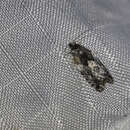Cyclicity
provided by University of Alberta Museums
Adult flight periods occur from mid June to early July (Pohl et al. 2010).
- license
- cc-by-nc
- copyright
- University of Alberta Museums
Distribution
provided by University of Alberta Museums
This genus has a primarily Holarctic range with seven species recognized in North America (Nova Scotia to British Columbia, south to New York and Arizona) (Gilligan et al. 2008, Fernald 1882, Pohl et al. 2010).
- license
- cc-by-nc
- copyright
- University of Alberta Museums
General Description
provided by University of Alberta Museums
"This genus has a forewing pattern that is uniform with the basal patch and median fascia well defined. This well defined region is also separated by an interfascial band of contrasting, lighter coloration. Male moths lack costal folds and notching near the base of their antennae. Male genitalia consist of a prominent clasper on the basal excavation margin and a cluster of long scales on the tegumen (near the area where the tegumen articulates with the vinculum). Female genitalia consist of two tacklike signa with some degree of sclerotization of the ductus bursae. The sculpturing of the sterigma is different between species (Heinrich 1923, Miller 1987, Gilligan et al. 2008).
This species have an alar expanse of 12-15mm (with forewings 5.5-7mm in length) (Heinrich 1924, Miller 1987). The forewings have dark areas and markings that are black in coloration. The hindwings are paler than the forewings. The palpi and head are white with grey dusting. In contrast, the thorax is dark grey with white dusting. This moth can be distinguished from other moths of this genus by the well defined, black basal patch. The white interfascial band is medially divided. Blackish-gray scales produce white costal and dorsal patches. This moth is the only midwestern species of its genus that has this degree black-charcoal scaling on the forewings (Gilligan et al. 2008)."
- license
- cc-by-nc
- copyright
- University of Alberta Museums
Habitat
provided by University of Alberta Museums
Inhabit boreal forests with occasional occurrence in small patches of grassland in boreal regions (Pohl et al. 2010).
- license
- cc-by-nc
- copyright
- University of Alberta Museums
Life Cycle
provided by University of Alberta Museums
In North America, this genus consists of leaf-rolling larvae that feed within their rolled leaves of Populus (Miller 1987). These larvae then pupate (mostly likely hibernate as larvae or pupae) and emerge from their leaf rolls as adults in July (Razowski 2003). Most likely multiple generations per year at lower latitudes.
- license
- cc-by-nc
- copyright
- University of Alberta Museums
Trophic Strategy
provided by University of Alberta Museums
The larva is a leaf-roller and feeds on Populus tremuloides (quaking aspen) (Prentice 1966).
- license
- cc-by-nc
- copyright
- University of Alberta Museums
Gypsonoma adjuncta
(
Dutch; Flemish
)
provided by wikipedia NL
Insecten Gypsonoma adjuncta is een vlinder uit de familie van de bladrollers (Tortricidae).[1] De wetenschappelijke naam van de soort is voor het eerst geldig gepubliceerd in 1924 door Heinrich.
Bronnen, noten en/of referenties Geplaatst op:
06-04-2013
Dit artikel is een beginnetje over biologie. U wordt uitgenodigd om op bewerken te klikken om uw kennis aan dit artikel toe te voegen.

- license
- cc-by-sa-3.0
- copyright
- Wikipedia-auteurs en -editors

